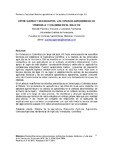Mostrar el registro sencillo del ítem
Entre sueños y desencantos. Los estudios agronómicos en Venezuela y Colombia en el siglo XIX
| dc.rights.license | http://creativecommons.org/licenses/by-nc-sa/3.0/ve/ | |
| dc.contributor.author | Pacheco Troconis, Germán | |
| dc.contributor.author | Taylhardat, Leonardo | |
| dc.date.accessioned | 2013-07-10T16:21:06Z | |
| dc.date.available | 2013-07-10T16:21:06Z | |
| dc.date.issued | 2013-07-10T16:21:06Z | |
| dc.identifier.issn | 2244-7008 | |
| dc.identifier.uri | http://www.saber.ula.ve/handle/123456789/37269 | |
| dc.description.abstract | En Venezuela y Colombia a lo largo del siglo XIX hubo preocupación de sus elites técnicas por establecer la Agricultura Científica, a la manera de las principales agriculturas de Occidente. Ello se inscribió en la necesidad de mejorar la posición competitiva de sus agriculturas en el contexto económico internacional. Como apoyo al logro de este objetivo la educación técnica y entre ella la agrícola fue considerada importante. Fueron auspiciados ciertos proyectos de educación agrícola, algunos lograron establecerse aunque su vida fue corta. Sólo para la tercera década del siglo XX se logró el establecimiento exitoso de las escuelas agrícolas técnicas y de los estudios agronómicos superiores, cuando concurrió una valorización social de estas carreras y se abrió una demanda técnica para las mismas. En el artículo reseñamos los intentos adelantados en Venezuela y Colombia desde el Estado, las sociedades de agricultores y las élites técnicas para implantar los estudios agronómicos y la carrera de agronomía en la centuria decimonónica, en el marco de la región, inscribiendo los mismos en el contexto social y económico que primó a lo largo de este proceso. Se identifican y analizan igualmente los obstáculos que hicieron de estos estudios en ambos países más que una realidad una utopía. Y se hacen un conjunto de reflexiones en la búsqueda de explicaciones que nos lleven a comprender por qué sólo hacia la tercera década del siglo próximo pasado (XX) estos proyectos pudieron ser una realidad. | es_VE |
| dc.language.iso | es | es_VE |
| dc.rights | info:eu-repo/semantics/openAccess | |
| dc.title | Entre sueños y desencantos. Los estudios agronómicos en Venezuela y Colombia en el siglo XIX | es_VE |
| dc.title.alternative | The agronomic studies in Venezuela and Colombia, in the siècle XIX: dreams and disappointments | es_VE |
| dc.type | info:eu-repo/semantics/article | |
| dc.description.abstract1 | During the nineteenth h and early twentieth century in Venezuela and Colombia the technical elites were preoccupied for to establish Scientific Agriculture, following the example of the leading agriculture West. It was necessary to improve the competitive position of their agricultures in the international economic context. For to get this objective the technical agriculture education was considered very important. Something projects about agricultural education were sponsored. Some of them could to establish but for a short time. Only since the third decade of the siècle XX the technical agricultural schools and higher agricultural studies were successfully. For this time the agriculture studies got a social value. In this paper we review the attempts carried out in Venezuela and Colombia since the government, the societies of agriculturalists and the technical elites for to implement the agricultural studies and the career of agronomy in the nineteenth century. This study makes the analysis in the Latin-American framework. It also identifies and analyzes the obstacles that confront these studies in these countries. Finally this article presents some reflections for to know why the projects might be a reality and overcome the utopia. | es_VE |
| dc.description.colacion | 3-29 | es_VE |
| dc.description.email | pachecogerman@hotmail.com | es_VE |
| dc.description.frecuencia | semestral | |
| dc.identifier.depositolegal | PPI200302ME3529 | |
| dc.subject.publicacionelectronica | Revista Bitácora-e | |
| dc.subject.seccion | Revista Bitácora-e: Artículo | es_VE |
| dc.subject.thematiccategory | Artes y Humanidades | es_VE |
| dc.subject.tipo | Revistas | es_VE |
| dc.subject.unidadinv | Grupo Venezolano de Historia y Sociología de la Ciencia (GVHSC) | es_VE |
| dc.type.media | Texto | es_VE |
Ficheros en el ítem
Este ítem aparece en la(s) siguiente(s) colección(ones)
-
Bitácora-e - 2012 - Número 002
julio - diciembre 2012


